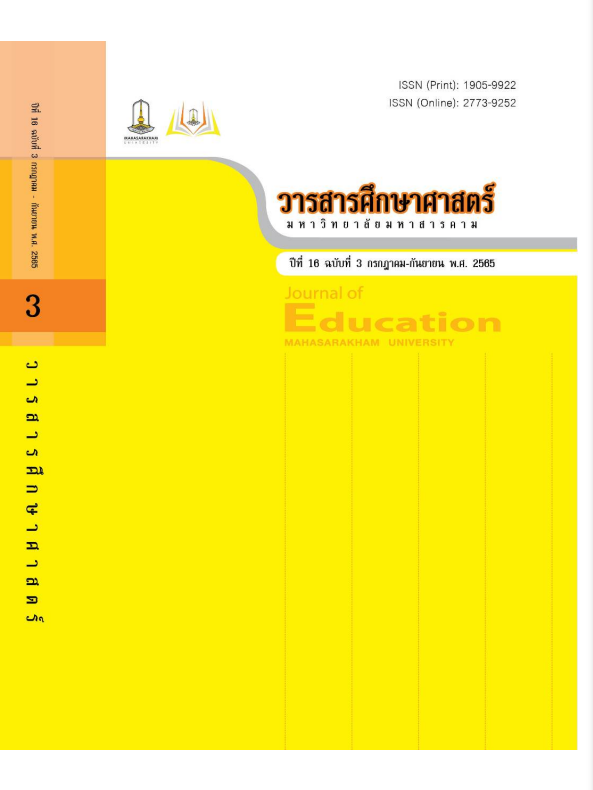The Development of the Spelling Skill Exercise on the Skill in Spelling Different Ending Consonants Together with Collaborative Learning by using STAD Technique for Elementary 3 Students
Main Article Content
Abstract
The objectives of this research were 1) to determine the efficiency of Thai Language skills practice on the skill in spelling different ending consonants together with collaborative learning by using STAD technique for elementary 3 students with 75/75 criteria of effectiveness and 2) to study the students’ spelling skills before and after using the spelling skill practice skills practice on the skill in spelling different ending consonants together with collaborative learning by using STAD technique for elementary 3 students. The sample consisted of 20 students in elementary school grade 3 at Ban Nong Rangsit School, under the Sukhothai Primary Educational Service Area Office 2, semester 2 of the academic year 2021, totaling 20 people obtained by purposive sampling method. The tools used in the research were 1) a learning management plan to be used with the spelling skill exercises on the subject of the skill in spelling different ending consonants together with collaborative learning by using STAD technique. 2) The spelling skill exercises on the subject of the skill in spelling different ending consonants together with collaborative learning by using STAD technique and 3) The spelling skill exercises on spelling different ending consonants. The statistics used to analyze the data were percentage, mean, standard deviation and t-test dependent statistical test. The results of the research appeared as follows:
1. The spelling skill exercises on the subject of the skill in spelling different ending consonants together with collaborative learning by using the STAD technique for elementary 3 students had E1/E2 value of 77.38/78.50, which exceeded the threshold of 75/75 according to the prescribed hypothesis.
2. Students after using the spelling skill exercises on the subject of the skill in spelling different ending consonants combined with cooperative learning using STAD technique, students had statistically significantly higher spelling skills than before at .05 level.
The results could be concluded that the STAD skills practice and collaborative learning techniques can help improve spelling skills on the subject of the skill in spelling different ending consonants. This is because STAD collaborative learning is a learning management process where learners learn together in small groups, which emphasizes on the exchange of ideas amongst the learners, which will help teaching Thai language to be more efficient.
Downloads
Article Details

This work is licensed under a Creative Commons Attribution-NonCommercial-NoDerivatives 4.0 International License.
References
กระทรวงศึกษาธิการ. (2551). หลักสูตรแกนกลางการศึกษาขั้นพื้นฐาน พุทธศักราช 2551. กรุงเทพฯ: กระทรวงศึกษาธิการ.
คำขวัญ ชูเอียด. (2554). แบบฝึกทักษะการเขียนตัวสะกดมาตรา กก กด กบ สำาหรับนักเรียนชั้นประถมศึกษาปีที่ 3 หลักสูตรภาษาอังกฤษ. สารนิพนธ์ ศศ.ม.(การสอนภาษาไทยในฐานะภาษาต่างประเทศ). กรุงเทพฯ: บัณฑิตวิทยาลัย มหาวิทยาลัยศรีนคตรินทรวิโรฒ.
จิรนันท์ กุญชะโมรินทร์. (2558). การพัฒนาแผนการจัดการเรียนรู้ทักษะการอ่านออกเสียงและเขียนคำศัพท์ภาษาอังกฤษ โดยจัดกิจกรรมการเรียนรู้แบบร่วมมือเทคนิค STAD ประกอบเกมของนักเรียนชั้นประถมศึกษาปีที่ 6. วิทยานิพนธ์ ค.ม. มหาสารคาม: มหาวิทยาลัยราชภัฏมหาสารคาม.
จุติพร เวฬุวรรณ. (2559). รายงานผลการจัดการเรียนรู้แบบกลุ่มร่วมมือ (STAD) ประกอบแบบฝึกทักษะอ่านเขียนเรียนภาษา ราชาธิราชกลุ่มการเรียนรู้ภาษาไทย ชั้นมัธยมศึกษาปีที่ 1. วารสารวิทยาลัยบัณฑิตเอเชีย, 6(1), 93-100.
ดาราณี โพธิ์ไทร. (2552). การพัฒนาแบบฝึกทักษะภาษาไทย เรื่อง การเขียนสะกดคำที่ไม่ตรงตามมาตราตัวสะกดโดยใช้การเรียนรู้แบบร่วมมือ สำหรับนักเรียนชั้นประถมศึกษาปีที่ 2. วิทยานิพนธ์ กศ.ม. มหาวิทยาลัยราชภัฎบุรีรัมย์, บุรีรัมย์.
ประทีป แสงเปี่ยมสุข. (2546). กระบวนการกลุ่มปฏิบัติมิติหนึ่งของการสอนที่เน้นผู้เรียนเป็นสำคัญ. กรุงเทพฯ: ปกรณ์ศิลป์พริ้นติ้ง.
ปาลิตา อิธิตา. (2563). การสร้างแบบฝึกทักษะ การอ่านและการเขียนมาตราตัวสะกดของนักเรียน ชั้นประถมศึกษาปีที่ 2 โรงเรียนบ้านมูเซอ. การค้นคว้าอิสระ การศึกษามหาบัณฑิต. พิษณุโลก: มหาวิทยาลัยนเรศวร.
พจนีย์ บุญสว่าง. (2558). การพัฒนากิจกรรมแบบร่วมมือโดยใช้เทคนิค STAD ที่ส่งเสริมความสามารถในการเขียนสะกดคำไม่ตรงตามมาตราตัวสะกดสำหรับนักเรียนชั้นประถมศึกษาปีที่ 3. วิทยานิพนธ์ กศ.ม. มหาวิทยาลัยนเรศวร, พิษณุโลก.
พลวัฒน์ ไหลมูน. (2560). การศึกษาวิเคราะห์คำไทยที่มักเขียนผิด. วารสารมนุษยศาสตร์, 24(2), 318-343.
ไพทูลย์ มูลดี. (2546). การพัฒนาแผนและแบบฝึกทักษะการเขียนสะกดคำที่ไม่ตรงตามมาตราตัวสะกดกลุ่มสาระการเรียนรู้ภาษาไทย ชั้นประถมศึกษาปีที่ 2. การค้นคว้าอิสระ การศึกษามหาบัณฑิต. มหาสารคาม: มหาวิทยาลัยสารคาม.
มะลิ อาจวิชัย. (2540). การพัฒนาแบบฝึกทักษะภาษาไทย เรื่องการเขียนสะกดคำไม่ตรงตามมาตราตัวสะกด แม่กน แม่กด และแม่กบ สำหรับนักเรียนชั้นประถมศึกษาปีที่ 3. วิทยานิพนธ์ กศ.ม. มหาวิทยาลัยมหาสารคาม, มหาสารคาม.
โรงเรียนบ้านหนองรังสิต. (2564). แผนปฏิบัติงานประจำปีโรงเรียนบ้านหนองรังสิต. สุโขทัย: กลุ่มงานบริหารโรงเรียนบ้านหนองรังสิต
วิมลรัตน์ สุนทรโรจน์. (2545). เอกสารประกอบการสอนวิชา สัมมนาหลักสูตรและการสอนภาษาไทย. มหาวิทยาลัยมหาสารคาม, มหาสารคาม.
วีระ ไทยพานิช. (2555). การออกแบบและพัฒนาระบบการสอน. กรุงเทพฯ: สำนักพิมพ์มหาวิทยาลัยรามคำาแหง.
สังวาล์ จันทร์เทพ. (2562). การใช้แบบฝึกเสริมทักษะพัฒนาการอ่านตัวสะกดไม่ตรงมาตรา ด้วยกิจกรรมการเรียนรู้ร่วมมือเทคนิค STAD สำหรับนักเรียนชั้นประถมศึกษาปีที่ 2 โรงเรียนเทศบาล 1 วัดพรหมวิหาร อำเภอแม่สาย จังหวัดเชียงราย. วารสารบัณฑิตวิจัย, 10(1), 23-40.
สุภจิต คงสุวรรณ. (2550). การพัฒนาแผนการจัดการเรียนรู้และแบบฝึกทักษะการเขียนสะกดคำที่ไม่ตรงตามมาตราตัวสะกดกลุ่มสาระการเรียนรู้ภาษาไทย. วิทยานิพนธ์ ค.ม. มหาวิทยาลัยมหาสารคาม, มหาสารคาม.

